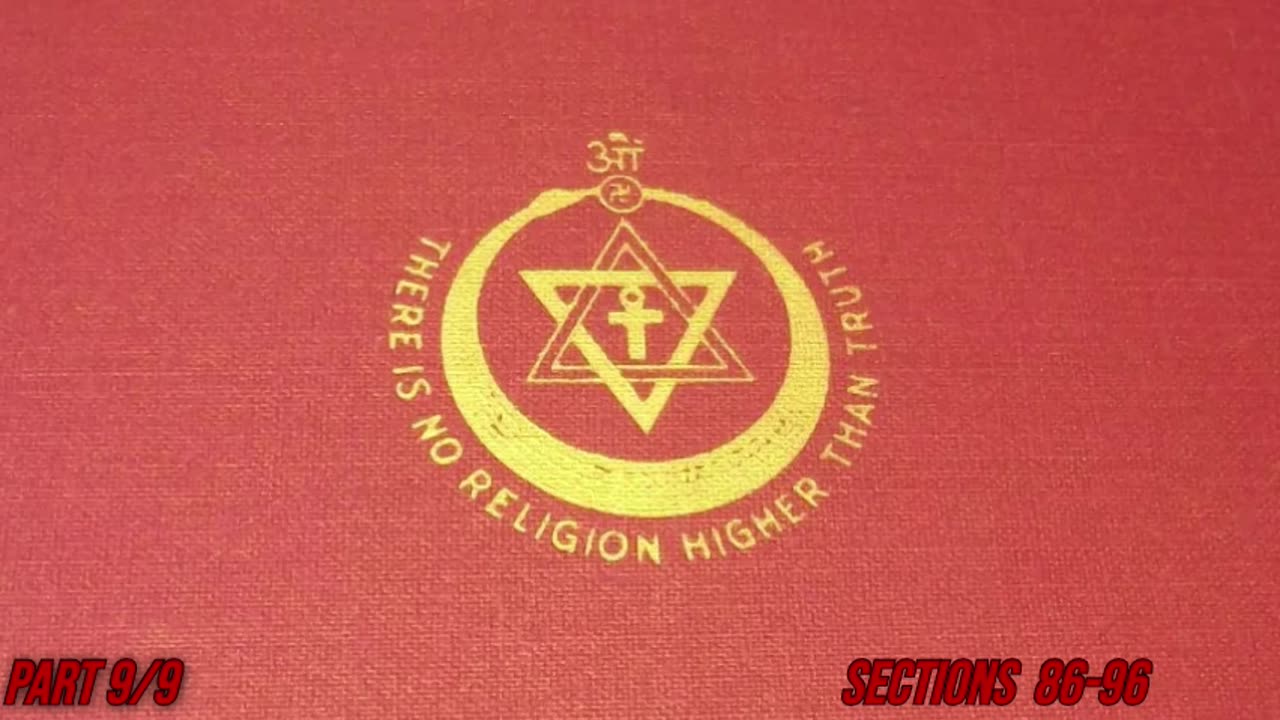Premium Only Content

The Secret Doctrine by Blavatsky Part 9/9 Sections 86-96
Part 9 (Sections 86-96) of "The Secret Doctrine" by Helena Petrovna Blavatsky serves as a culmination of the themes discussed throughout the work, focusing on the final synthesis of esoteric philosophy, cosmic evolution, and the mystical journey of humanity. In this part, Blavatsky aims to tie together the concepts of ancient wisdom, spiritual science, and theosophical teachings that she has presented, offering a broader perspective on the purpose of life and the destiny of the universe.
Overview of Part 9:
Blavatsky explores the relationship between humanity and the divine in this final section, emphasizing how spiritual evolution is not just a personal journey but a collective cosmic process that aligns with the laws of the universe. She delves into the spiritual destiny of humankind, the role of esoteric traditions in guiding this process, and the future cycles of evolution that lie ahead for both individual souls and civilizations. Blavatsky also reflects on the role of theosophy in modern times, framing it as a spiritual revival of the ancient wisdom traditions.
Key Concepts and Sections in Part 9:
1. The Unity of All Life and the Cosmic Web:
Blavatsky emphasizes the interconnectedness of all beings, both spiritual and material, arguing that the universe is a single, living organism. She reiterates the idea that all life is interconnected through a cosmic web, where each individual soul plays a role in the grand design.
This section touches on the concept of universal consciousness, suggesting that enlightenment involves recognizing the divine spark that exists within every living being. Blavatsky draws upon Eastern teachings, such as Advaita Vedanta and Buddhist principles, to support her claims about the unity of existence.
2. The Role of Theosophy and Spiritual Science:
Blavatsky positions theosophy as a spiritual science that seeks to reconcile modern science with ancient metaphysics. She critiques the materialistic approach of contemporary science, arguing that it ignores the spiritual dimensions of reality.
In this part, she outlines the purpose of the Theosophical Society as a means of reviving ancient knowledge and guiding humanity towards a higher understanding of the laws of nature. She emphasizes that theosophy is not just a philosophy but a way of life that fosters compassion, self-awareness, and universal brotherhood.
3. Cycles of Time and Future Ages:
A significant focus in this part is on the cyclic nature of time and the future evolution of humanity. Blavatsky discusses the next root races that will arise after the current Aryan root race, predicting that these future races will possess higher spiritual capacities and greater attunement to cosmic forces.
She explores the idea of spiritual epochs and Golden Ages, where spirituality and higher consciousness flourish, followed by dark ages where materialism and ignorance dominate. According to Blavatsky, humanity is currently at a turning point, where it must choose between spiritual awakening and further descent into materiality.
4. The Secret Doctrine’s Role in Preparing for the Future:
Blavatsky sees "The Secret Doctrine" as a manual for spiritual seekers who are preparing for the coming spiritual awakening. She believes that the teachings in her work offer keys to understanding the occult laws that will become more evident as humanity enters the next stages of evolution.
She encourages readers to study the esoteric doctrines and ancient symbols presented throughout the book as a means of aligning themselves with the cosmic rhythm and spiritual truths that govern the universe.
5. Karmic Law and Spiritual Responsibility:
Blavatsky reiterates the importance of karma as a guiding principle in individual and collective evolution. She emphasizes that spiritual progress requires self-discipline, ethical living, and compassionate action, as these practices align individuals with the harmonious flow of universal law.
This part discusses the responsibility of spiritual aspirants to awaken others and to act as beacons of light in times of materialism and spiritual darkness. Blavatsky views this role as crucial for ensuring that the next cycle of spiritual awakening unfolds in accordance with the highest principles.
6. Esoteric Symbolism of Light and Darkness:
Blavatsky delves into the symbolism of light and darkness, exploring their esoteric meanings beyond their literal interpretations. Light represents spiritual wisdom, divine knowledge, and the enlightenment of the soul, while darkness symbolizes ignorance, material entrapment, and the obscuring of spiritual truths.
She draws on alchemical symbolism, Gnostic teachings, and mystical poetry to illustrate how these concepts have been used throughout history to describe the inner struggle between the spiritual self and material desires. Blavatsky suggests that alchemy, in particular, encodes the process of transforming the self from base materialism into spiritual gold.
7. Reflections on Ancient Civilizations and Their Wisdom:
In the concluding sections, Blavatsky reflects on the lost wisdom of ancient civilizations, such as Atlantis, Egypt, Babylon, and India, suggesting that they possessed a deeper understanding of the cosmic order. She believes that the esoteric knowledge of these cultures was preserved in sacred architecture, temples, pyramids, and mythological texts.
Blavatsky calls for a renewed appreciation of the ancient wisdom tradition, suggesting that humanity's future depends on its ability to reconnect with these mystical teachings. She argues that the spiritual awakening of the present age involves recovering the knowledge that has been hidden or forgotten over time.
Purpose of Part 9:
The aim of this section is to synthesize the major themes of "The Secret Doctrine", offering a vision for humanity’s future based on the universal principles and ancient wisdom outlined in earlier sections. Blavatsky emphasizes the spiritual responsibilities of individuals and esoteric groups in guiding the evolution of consciousness.
Blavatsky presents theosophy as a blueprint for spiritual regeneration, encouraging readers to view their personal growth as part of a cosmic plan that transcends individual lifetimes.
Style and Presentation:
Blavatsky’s tone in this final part is philosophical and reflective, as she weaves together the mystical, historical, and cosmological themes of her work into a cohesive vision. She writes with a sense of urgency, aiming to inspire spiritual seekers to take action in their personal lives and spiritual practices.
The style remains complex, filled with references to mystical traditions, spiritual hierarchies, and cosmic cycles, as she seeks to provide a holistic view of human evolution.
Significance of Part 9:
Part 9 serves as the culmination of Blavatsky's esoteric teachings, offering a holistic vision of humanity’s place in the cosmos and the spiritual journey that lies ahead. It reinforces the idea that spiritual enlightenment is both an individual quest and a collective process.
This part is particularly significant for students of theosophy and Western esotericism, as it lays out a framework for understanding how ancient wisdom can guide modern spiritual movements and foster a new era of spiritual understanding.
ABOUT THE AUTHOR:
Helena Petrovna Blavatsky (1831-1891)
Helena Petrovna Blavatsky—often known simply as Madame Blavatsky or HPB—was a Russian occultist, mystic, and co-founder of the Theosophical Society, a movement that sought to reconcile spirituality with science and philosophy by drawing upon ancient esoteric traditions. Born on August 12, 1831, in Ekaterinoslav, then part of the Russian Empire (now Dnipro, Ukraine), she is widely considered one of the most influential figures in the modern esoteric and occult revival of the late 19th century. Her writings and teachings, particularly "Isis Unveiled" (1877) and "The Secret Doctrine" (1888), continue to shape New Age thought, Western esotericism, and spiritual movements to this day.
Early Life and Influences
Blavatsky was born into a noble Russian family, with her mother, Helena Andreyevna von Hahn, being a novelist and her father, Colonel Peter Hahn, serving in the Russian military. From a young age, she displayed an interest in the mystical and supernatural, with accounts of her life mentioning experiences with clairvoyance, telepathy, and astral travel. Her family's access to Western literature and philosophy exposed her to esoteric ideas early on, which she later developed into her own theosophical framework.
In her early adulthood, Blavatsky embarked on extensive travels that took her across Europe, the Middle East, India, and Tibet. During these journeys, she claimed to have studied with esoteric teachers and initiates, particularly in India and Tibet, who taught her the ancient wisdom traditions that would form the core of her later teachings.
Founding of the Theosophical Society
In 1875, Blavatsky co-founded the Theosophical Society in New York City with Henry Steel Olcott and William Quan Judge. The society aimed to:
1. Promote the study of comparative religion, philosophy, and science.
2. Investigate unexplained laws of nature and the powers latent in humanity.
3. Promote universal brotherhood, transcending distinctions of race, creed, sex, caste, or color.
The Theosophical Society played a pivotal role in introducing Eastern philosophies, such as Hinduism and Buddhism, to the Western world, promoting the idea that all religions contain an underlying spiritual truth. Blavatsky served as the spiritual head of the movement, positioning herself as a messenger for the hidden masters or Mahatmas, whom she claimed were enlightened beings guiding the spiritual evolution of humanity.
Key Works and Esoteric Teachings
"Isis Unveiled" (1877): Blavatsky’s first major work sought to challenge materialism and scientific reductionism, arguing that ancient wisdom held the keys to understanding spiritual phenomena and the hidden aspects of nature. The book covered a wide range of subjects, from mythology to comparative religion, psychic phenomena, and occult sciences.
"The Secret Doctrine" (1888): This two-volume work is considered her magnum opus. It lays out a cosmological vision based on the Stanzas of Dzyan, which she claimed were ancient texts from Tibet. The first volume, "Cosmogenesis", focuses on the origin of the universe and cosmic evolution, while the second volume, "Anthropogenesis", explores the esoteric history of humanity through the seven root races. Blavatsky aimed to provide a synthesis of science, religion, and philosophy, drawing upon Eastern mysticism, Hermeticism, and Kabbalistic traditions.
Affiliations with Secret Societies
Blavatsky’s life and work were deeply intertwined with the esoteric traditions and secret societies that she studied and promoted. While there is some ambiguity surrounding her precise affiliations, her connections to various mystical and occult orders are well-documented:
1. Freemasonry:
Blavatsky claimed connections with Freemasonry, particularly through Co-Freemasonry and esoteric branches of the craft that included women, which was unusual for traditional Freemasonry. She was associated with Rite of Adoption lodges, a branch of Continental Masonry that allowed female members.
Her writings often reflect a Masonic worldview, utilizing symbolism and concepts familiar to Masonic teachings, such as the spiritual significance of geometric shapes and initiatory practices.
2. Rosicrucianism:
Blavatsky’s teachings frequently align with Rosicrucian ideals, emphasizing the existence of a hidden knowledge that dates back to ancient Egypt, Hermeticism, and alchemical traditions. She often spoke of the Rosicrucians as being among the guardians of ancient wisdom.
While no direct records confirm her initiation into a formal Rosicrucian order, Blavatsky’s writings suggest a deep sympathy for Rosicrucian principles, particularly in her emphasis on spiritual alchemy and the transmutation of the soul.
3. Hermetic Brotherhood of Luxor:
Blavatsky’s early writings and teachings have connections to the Hermetic Brotherhood of Luxor, a 19th-century occult order that combined Egyptian mysteries with Western esotericism. Some sources suggest that she had correspondences with members of this brotherhood, sharing a common interest in ancient Egyptian mysticism.
The Hermetic principles she discusses in her writings, such as the Law of Correspondence ("As above, so below"), reflect the influence of Hermetic thought on her theosophical worldview.
4. Kabbalistic Traditions:
Blavatsky’s work is heavily influenced by Jewish Kabbalah, which she viewed as a repository of esoteric wisdom with roots in ancient Chaldean and Egyptian mysticism. She believed that Kabbalistic teachings were closely related to the mysteries of the East, drawing parallels between Kabbalistic concepts and Vedic philosophy.
Although not formally initiated into any Kabbalistic society, Blavatsky incorporated Kabbalistic symbols, such as the Sephiroth and the Tree of Life, into her interpretation of the cosmos and spiritual evolution.
Controversies and Criticisms
Blavatsky’s life and work were marked by significant controversy. She faced criticism and skepticism from the scientific community of her time, as well as from Christian missionaries who opposed her promotion of Eastern religions in the West. Her claims of communication with the Mahatmas were challenged by skeptics, most notably during the Hodgson Report published by the Society for Psychical Research in 1885, which accused her of being a charlatan. However, many of her followers continued to believe in her spiritual authority and the validity of her occult experiences.
Legacy and Impact
Blavatsky’s influence extends far beyond her lifetime, shaping the New Age movement, Western occult traditions, and esoteric schools of thought. Her emphasis on the unity of all religions, the divine nature of the cosmos, and the importance of spiritual evolution has had a profound impact on mystical traditions and philosophical inquiries into the nature of reality. The Theosophical Society she co-founded continues to have branches around the world, promoting the study of esoteric philosophy and spiritual science.
Helena Petrovna Blavatsky remains a polarizing figure—revered by many as a spiritual visionary and pioneer of esoteric thought, while criticized by others as a controversial mystic with unorthodox ideas. Regardless of perspective, her role in reshaping the Western spiritual landscape and bridging Eastern and Western philosophies is undeniable, making her a central figure in the history of modern esotericism.
-
 24:22
24:22
Deus Meum Que Jus
18 days agoFreedom on the Altar with William Norman Grigg
3501 -
 2:09:28
2:09:28
Melonie Mac
11 hours agoGo Boom Live Ep 39!
59.8K10 -
 1:04:36
1:04:36
Man in America
13 hours ago🚨 BREAKING: Dr. Robert Young JAILED! Medical Tyrants Will Do ANYTHING to Silence Truth
63.7K28 -
 3:01:44
3:01:44
I_Came_With_Fire_Podcast
11 hours agoPanama CANAL BlackROCKED | Left of PODCASTING | Ukraine AID GONE
35K7 -
 45:56
45:56
Glenn Greenwald
10 hours agoLee Fang Reacts to Trump's Speech to Congress; Will DOGE Tackle Military Waste? | SYSTEM UPDATE #418
111K96 -
 43:23
43:23
Donald Trump Jr.
10 hours agoNo Clap: Dems are a Disgrace but My Father is Bringing Back Common Sense | Triggered Ep.222
151K126 -
 18:29
18:29
The Rad Factory
1 day ago $3.24 earnedBuilding Shred Eighty a Custom Honda Snow Kart
47.2K6 -
 UPCOMING
UPCOMING
Precision Rifle Network
1 day agoS4E7 Guns & Grub - What makes group size increase?
31.9K2 -
 46:29
46:29
SGT Report
1 day agoAMERICA IS BACK! BYE BYE IRS!! -- Sam Anthony
70.7K98 -
 8:56:13
8:56:13
Dr Disrespect
16 hours ago🔴LIVE - DR DISRESPECT - WARZONE - 150 PLAYER LOBBIES
187K20